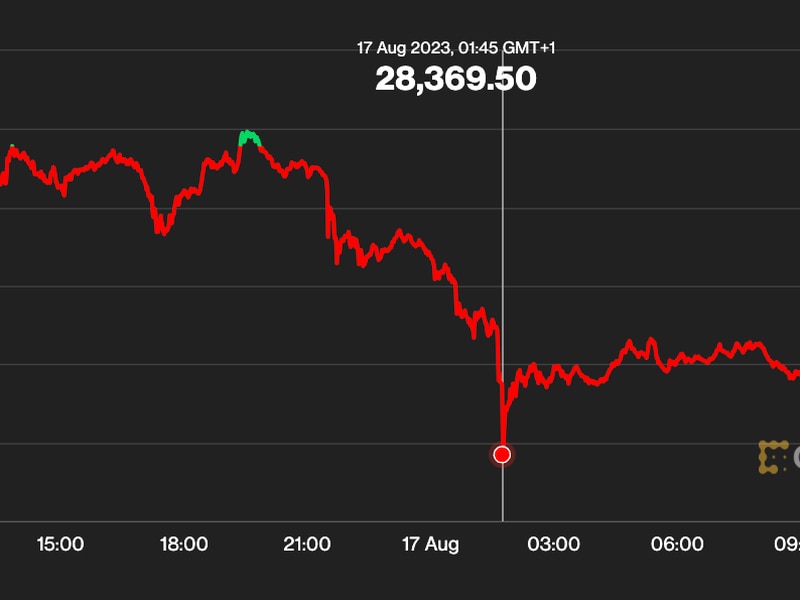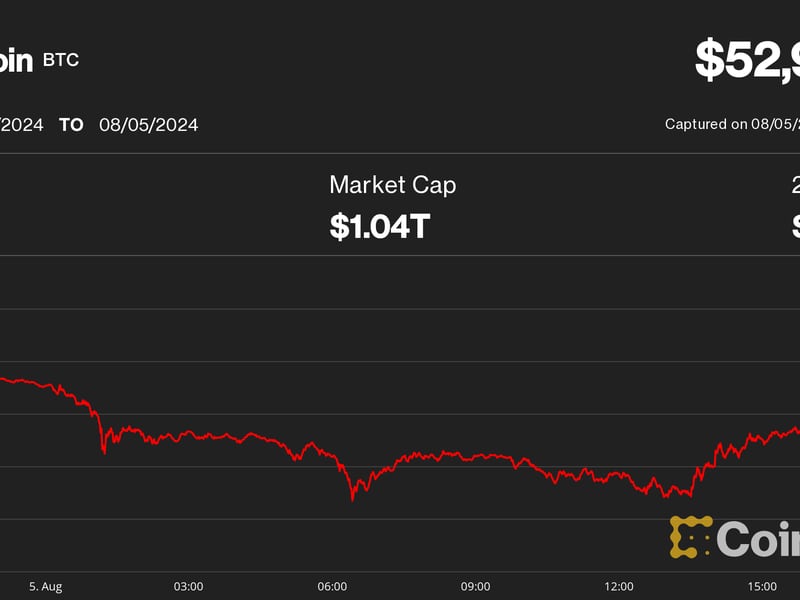Crypto Long & Short: Mining Derivatives Point to Growing Sophistication
Credit: Shutterstock/GG Photos
Crypto Long & Short: Mining Derivatives Point to Growing Sophistication
Well, it happened. Block 630,000 was processed on the Bitcoin blockchain (while we were on the air with our Crypto Long & Short show on Monday, how cool is that!), and the bitcoin subsidy paid to miners was cut from 12.5 bitcoins to 6.25. It felt momentous, as we all witnessed a pre-programmed economic system immutably do its thing. (Allen Farrington’s essay beautifully describes what it meant to those of us watching.)
Many of you are probably breathing a sigh of relief now that you don’t have to hear about the halving again for a few years. Understandable – it has dominated the crypto conversation over the past few months. But one feature will not disappear: the focus on bitcoin mining. This conversation is worth continuing, as it births new business models and new financial products that in turn open up new investment opportunities and risks.
You’re reading Crypto Long & Short, a newsletter that looks closely at the forces driving cryptocurrency markets. Authored by CoinDesk’s head of research, Noelle Acheson, it goes out every Sunday and offers a recap of the week – with insights and analysis – from a professional investor’s point of view. You can subscribe here.
Last week I wrote about how bitcoin mining was “growing up,” becoming more structured, scaled and financialized. The trend is continuing in leaps and bounds.
This week, derivatives exchange FTX launched what they are calling “hashrate futures.” Technically, they are not hashrate futures, they are difficulty futures. What’s the difference? Hashrate represents the computational power at work processing bitcoin transaction blocks. Since we don’t know at any given time how many miners are active and with which machines, the figure is an estimation derived from the difficulty level and the time between blocks.
The difficulty level refers to the requirements for successfully processing a transaction block. Miners have to find a random number that, when added to the block and run through the hash algorithm, produces a string with a certain number of zeroes at the beginning. The more zeroes, the harder the challenge. If blocks are being successfully processed too quickly, the difficulty rate adjusts upward, and the opposite if blocks are taking too long.
Both variables affect the amount of electricity a miner will have to consume. Being able to hedge either will remove some of the uncertainty around the mining business model, much like an airline hedges its fuel cost. Admittedly, airline revenues aren’t as volatile as bitcoin miner revenues, but the market is not short of instruments that let miners hedge their income. Hedging mining costs, on the other hand, is a relatively new concept that could, when more extended, have a fundamental impact on the sector’s profitability and resilience. Less uncertainty around costs could encourage more investment in bitcoin mining, which in turn could bring more security to the network.
This particular instrument may or may not take off. Its significance is more that it could trigger a new wave of financial innovation that supports the growth and increasing sophistication of the bitcoin mining industry, which is struggling to adjust to reduced revenue and tougher competition. All this, just as the world is paying more attention to its output.
Trust in Crypto Tells a Tale
Earlier this week, PR firm Edelman published a special edition of its famed Trust Barometer report, focused on cryptocurrency.
While the sample size is relatively large for a survey (+34,000 people over 18 years old, across 28 countries), it is still limited and so these findings are no more than an unverifiable indication of global sentiment. They are, however, revealing, and have some intriguing messages hidden between the lines.
First, some background: Edelman started these surveys in 2001, to gauge the public’s most pressing concerns and its level of comfort with established institutions. Its 2020 annual survey, published in January, before the Covid-19 crisis reached its peak, revealed a world already stressed about the role of technology in the economy. According to the results, over two-thirds of the population feel that the pace of change is too fast. Over 80% are worried they will lose their job to automation. And more than half believe that capitalism causes more harm than good. The survey is worth checking out, if only for a reminder that the current crisis we are living through is not just because of the pandemic.
Now, on to some of the data points from the cryptocurrency edition:
- Almost 50% of the multi-market survey sample trust cryptocurrencies, up 11 points from last year and only 10 points less than the percentage of those that trust banks. That sounds encouraging, until you notice that only 34% of U.S. respondents answered in the affirmative, down slightly on 2019. Over 80% of Chinese respondents, however, trust crypto, up 10 points on 2019. Western media often treats the U.S. as cryptocurrency’s largest potential market – this shows that perhaps we’re wrong.

- Other countries with a strong jump in the trust factor are Argentina (+25 points!), Mexico, Colombia and Brazil. These are, perhaps not coincidentally, the countries whose currencies have most depreciated against the dollar over the past 12 months.

- One outlier is South Africa, whose currency has depreciated by 30%, while its apparent trust of crypto has jumped only nine points to reach a relatively lackluster 49%. This may be a geography to watch, especially since, as Delphi Digital pointed out in its latest State of Bitcoin report, the price of bitcoin denominated in South African rand has increased a whopping 60% so far this year.

- Moving on, only 35% of respondents believe that cryptocurrencies and blockchain technology will have a net positive impact. In the U.S., this figure is an unenthusiastic 26%. Look at the figure for China, though: a substantial 62%. Yes, proportionally, China has more than double the conviction of the U.S. in blockchain’s potential. Combine this with the strong push from all levels of government for blockchain application research, and the imminent launch of the Chinese digital currency, and you get even more of a sense of a blockchain powerhouse emerging.

- Finally, the report reveals a strong push for more centralized control over crypto markets. More than 60% of respondents believe that cryptocurrency needs more regulation. Unsurprisingly, the call for regulation is greater in those countries with low trust levels (Italy, Spain, Hong Kong), but even in areas with high trust levels, over 50% of respondents think that the sector is not regulated enough.
- This hints at widespread mainstream support for licensing and FATF rules. As regulations are rolled out, we could see mainstream comfort and adoption levels grow.
All in all, this report indicates a notable increase in global understanding and support of crypto currencies. Of the 28 markets surveyed, only three had lower trust in cryptoassets than last year, and the declines were negligible. One of these was the U.S., however, which will be a narrative to watch.
As currency turmoil starts to crowd out other worrying headlines, as fractures in traditional institutions continue to emerge, and as the never-ending crypto education process continues, trust in crypto assets and blockchain technology is likely to continue to spread across emerging markets. This in turn will impact the value proposition and trust from investors and builders in more developed economies.
And, there’s bitcoin’s resilience. As hedge fund manager Paul Tudor Jones said on CNBC earlier this week: “Every day that goes by and bitcoin survives, the trust in it will go up.”
Anyone know what’s going on yet?
In spite of the hype around the halving and the crypto-laden virtual air around our massive Consensus: Distributed event, bitcoin had a lackluster week, falling 1%. Gold and long-term bonds did better, edging slightly up on persistent concerns about inflation, deflation or perhaps both.

It’s interesting to note that the more tech-heavy Nasdaq Composite has consistently outperformed its much larger sibling, and is almost flat on the year, while the S&P 500 is down more than 11%. Bitcoin is up over 35%, outperforming even gold.
The economic hits keep on coming: The UK and Germany, Europe’s two largest economies, are now officially in recession, and Brexit has reared its contentious head again. The pound joined a host of other currencies in their continued depreciation against the dollar. The question on many analysts’ worry lists is how long this currency tension can continue before something snaps.
(Note: Nothing in this newsletter is investment advice. The author owns small amounts of bitcoin and ether.)
CHAIN LINKS
Well-known hedge fund manager Paul Tudor Jones II has confirmed he has invested somewhere between 1% and 2% of his assets in bitcoin. TAKEWAY: This detail comes on top of the revelation last week that his fund was looking at investing in bitcoin futures on the CME, and underlines his conviction which appears to go beyond that of short-term trading gains. Tudor Jones’ comments show that he is not a bitcoin bull – he recognizes that it is a nascent type of asset, and may not succeed – but he’s evaluated the risk profile and believe there is greater upside than downside, especially given the current macroeconomic environment.
Crytpo research team Delphi Digital published a comprehensive report on bitcoin, covering network metrics, market performance, software upgrades and underlying narratives. TAKEAWAY: There’s a lot to unpack here, and something for everyone, but I found sections on wallet balances and on emerging markets particularly interesting. So far this year, the number of small holders (less than 1 BTC) has gone up over 6%, which indicates a growth in retail interest. The number of large holders (more than 10,000 BTC) has declined by 2%, which indicates either profit taking, or traders exiting, spooked by the volatility.

Coin Metrics analyzed the timestamp of stablecoin transfers to glean more information as to their use. It turns out that most tether, USDC and PAX transactions occur during Asian and European hours. DAI transfers, on the other hand, are concentrated in U.S. hours. TAKEAWAY: Interesting that programmatic stablecoins such as DAI are less appealing to Asian and European investors than those in the U.S. Another takeaway is that tether and USDC usage is more concentrated than PAX, which implies a higher degree of institutional use.

The Wall Street Journal reported that JP Morgan was now offering banking services to crypto exchanges Coinbase and Gemini. TAKEAWAY: This strong sign of increasing legitimacy of crypto businesses in the eyes of legacy finance, and should assuage investors’ concerns as to the reliability of crypto market infrastructure.
PwC released its annual Crypto Funds report, compiled in collaboration with fund manager Elwood, which revealed some interesting trends:
– A quantitative strategy is the most common by far, accounting for almost 50% of the crypto fund universe (which, for purposes of this report, does not include crypto index or venture capital funds).
– Almost 90% of crypto fund investors are either family offices or high-net worth individuals.
– The total AUM more than doubled over 2019, in spite of the bear market.
– The percentage of funds with more than $20 million AUM doubled over 2019.
– Bitcoin-only funds easily outperformed all other types in 2019.
– Approximately 40% of crypto funds are also involved in staking, lending or both, which indicates a deepening familiarity with sector developments.
– 56% actively use derivatives.
– Over 80% use an independent custodian, vs just over 50% in 2018.
– Over 40% are domiciled in the Cayman Islands, which, as well as a favorable tax regime, also gives them a wide range of exchanges from which to choose.

As further evidence that bitcoin-only funds have been outperforming, performance figures for Pantera Capital – one of the oldest and largest crypto fund managers in the sector – show that its flagship bitcoin fund lost 75.6% in 2018 and gained 87.7% in 2019, according to internal materials seen by CoinDesk. This brings the fund’s historical returns to 10,162%. TAKEAWAY: The relative outperformance of bitcoin funds could be interpreted as a sign that the sector is still young – new institutional money is likely to gravitate towards the oldest and largest cryptocurrency, for its liquidity and robustness. However, as the sector matures, more diversified funds are likely to rise in prominence, especially as bitcoin so far this year is underperforming equally weighted indices representing a broader range of tokens.

From the PwC/Elwood report mentioned above, we can infer a growing institutional interest in staking, in which investors earn rewards for locking up their holdings in order to participate in network governance. This past week, the Proof of Stake Alliance published a series of standards around marketing language, designed after conversations with regulators. TAKEAWAY: In last year’s PwC report, staking was barely mentioned. This year the report specifies that almost 40% of crypto funds are involved in crypto lending, staking or both. This points to growing sophistication amongst funds and investors. Staking is still a marginal crypto investment opportunity, but is likely to continue to grow as proof of stake networks evolve and as ethereum edges towards its protocol shift.
A blog post from crypto exchange Coinbase points out that bitcoin’s dominance wanes in bull markets. TAKEAWAY: The post’s author hypothesizes that this could be because investors become confident enough on their bitcoin bets to other possible category winners. It could also be because a bear market sees a flight to “relative” safety, away from smaller tokens and toward the more established bitcoin. Retail investors, however, show a propensity to trade other tokens in times of volatility, at higher levels than their market caps would suggest. 75% of Coinbase customers, who are mostly retail, have purchased crypto assets other than bitcoin.
Speaking at Consensus: Distributed, Brian Brooks, chief operating officer of the U.S. Office of the Comptroller of the Currency (OCC), said that he believes crypto companies could fall under a federal licensing regime rather than state-level money transmitter licenses. TAKEAWAY: This would lead to a more regulated and robust market infrastructure, which would boost both entrepreneurial and investor interest in crypto assets. It could also be enough to tempt some legacy financial institutions to set up crypto arms, injecting a further dose of legitimacy.
Binance.US has launched an OTC desk to enable trades of over $10,000. TAKEAWAY: U.S.-based institutions are still at this stage more likely to accumulate positions through the CME or the “blue chip” OTC desks such as B2C2 – but the potential market for Binance OTC amongst large traders and high-net-worth individuals could still be considerable, and the service could act as an additional on-ramp for large investors. It remains to be seen whether the OTC option will increase the overall volumes for Binance.US, or siphon off some of the exchange data as existing clients choose the more bespoke trading.
Crypto platform ErisX has become the first regulated U.S.-based exchange to offer ether futures contracts. These will be physically delivered with monthly and quarterly expirations. TAKEAWAY: This could change the attractiveness of ether as an investment asset from an institutional point of view – professional investors rarely take long-only or short-only bets, and the existence of regulated futures makes positions easier to hedge. But there is virtually no demand for physically settled bitcoin futures on ErisX, and relatively little demand elsewhere: Bakkt’s physically settled volume is miniscule compared to the CME’s cash-settled volume. So, will there be demand for ether futures? Another factor in demand is leverage, or in this case the lack of. On the other hand, the CME does not yet trade ether futures, so interested investors don’t have much to choose from.

Hut 8 Mining, one of Canada’s largest mining operations, reported falling revenue, decreased adjusted EBITDA margin and increased collateral requirements on debt in Q1. TAKEAWAY: This makes the third consecutive quarter revenue has declined, with the price increase failing to offset a decrease in the number of bitcoin mined – figures to watch as the subsidy per block going forward will be half what it was in Q1. (For more detail on Hut 8, see our in-depth report.)
Brooklyn Nets guard Spencer Dinwiddie spoke at Consensus: Distributed about his push to offer a piece of his future cash flows to investors via a crypto token. TAKEAWAY: Early days yet, and it remains to be seen what legal kinks have yet to emerge – but this offers a peek into a potential future in which sports contracts could be traded like securities, and fantasy football becomes a new type of portfolio management.
Podcasts from the week worth listening to:
- The Great Monetary Inflation – Paul Tudor Jones’ Complete Case for Bitcoin
- Macro Voices – Dr. Ben Hunt: Charting the post COVID-19 economic recovery
- Unconfirmed – Bitcoin at the 3rd Halving: What We See From On-Chain Data, with Yan Lieberman of Delphi Digital
- Unqualified Opinions – Layer 1 CEO Alex Liegl on the Institutionalization of Bitcoin Mining in America
- The Pomp Podcast – Cullen Roche Explains the Ultimate Breakdown of the Federal Reserve

Disclosure Read More
The leader in blockchain news, CoinDesk is a media outlet that strives for the highest journalistic standards and abides by a strict set of editorial policies. CoinDesk is an independent operating subsidiary of Digital Currency Group, which invests in cryptocurrencies and blockchain startups.









